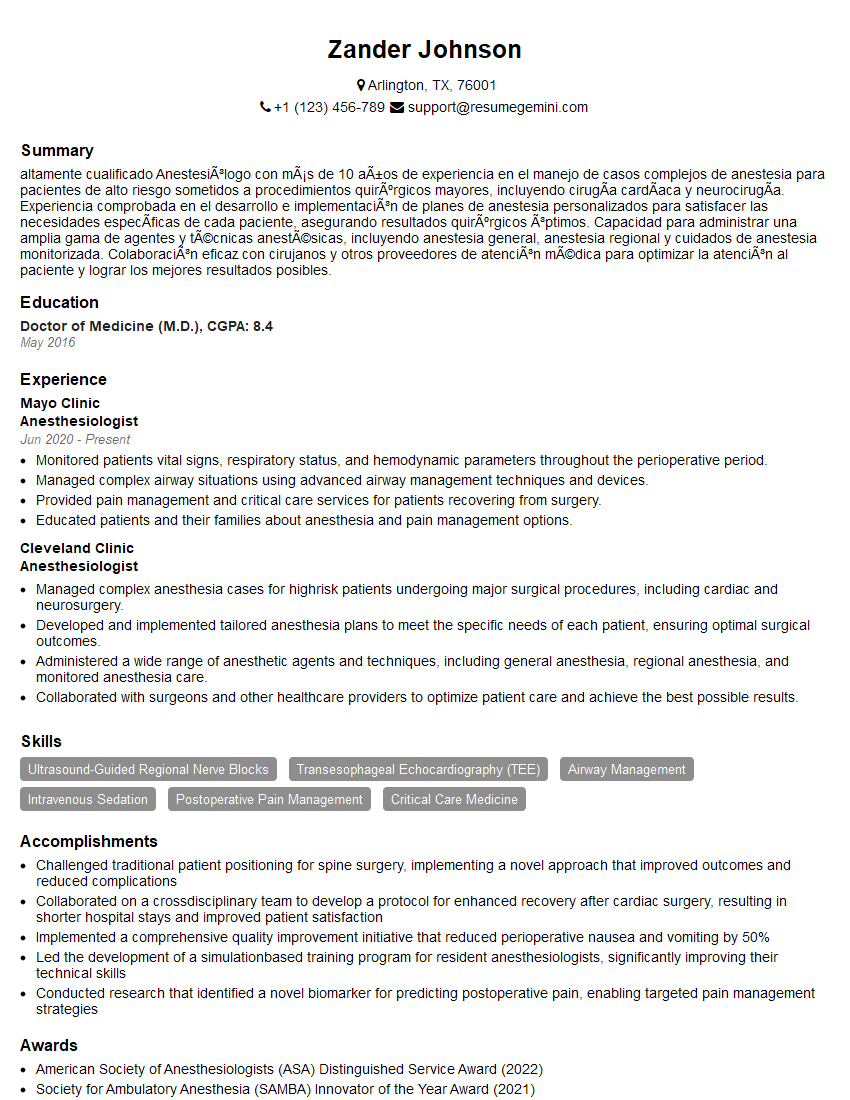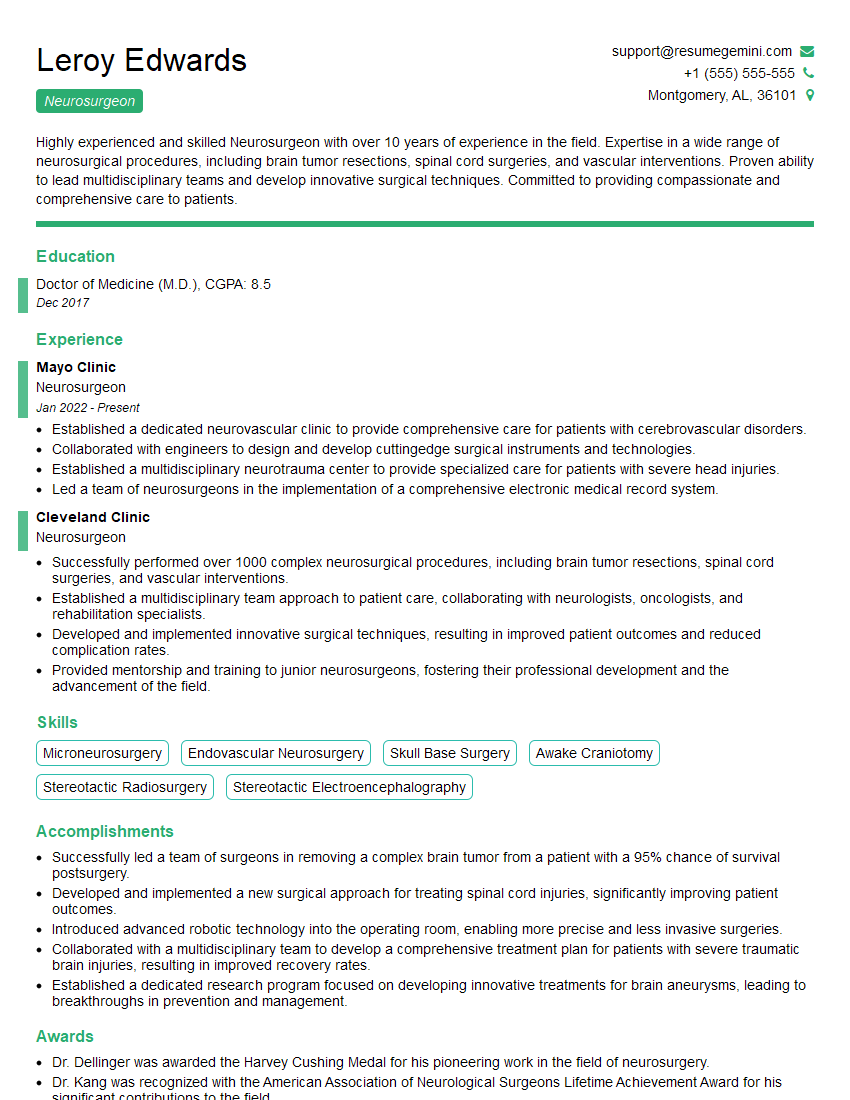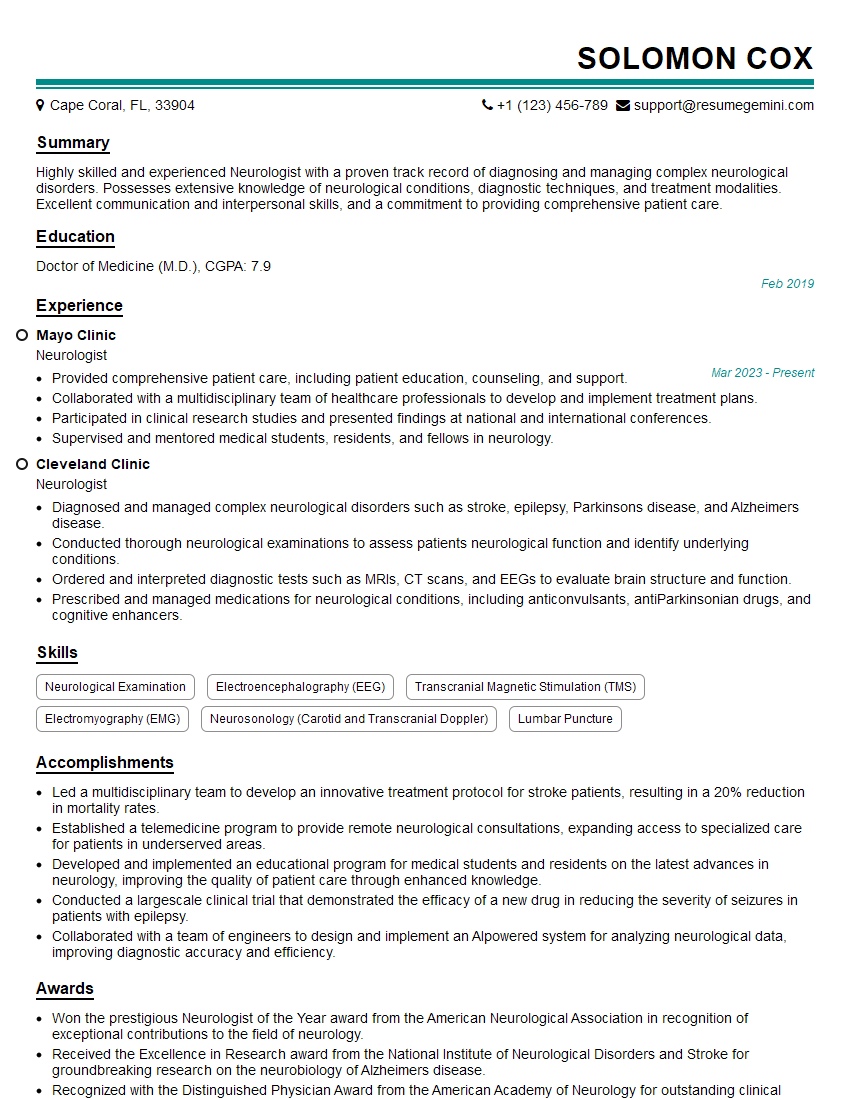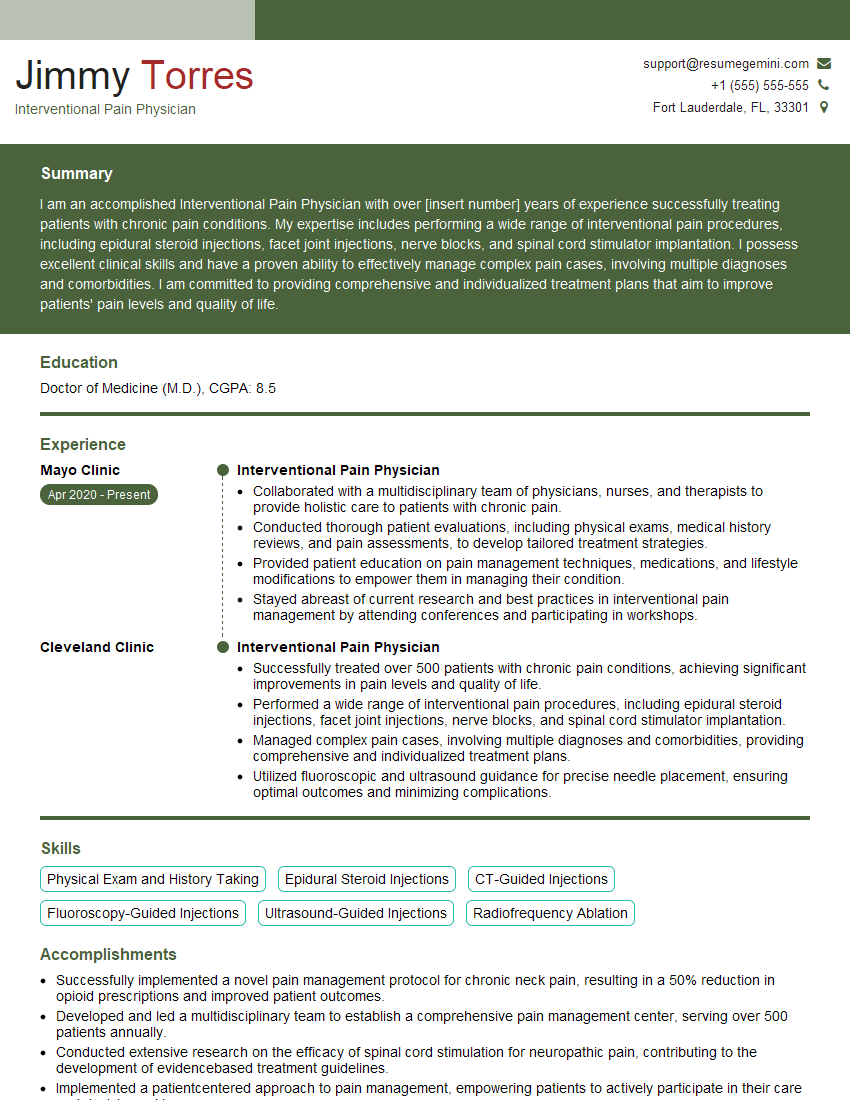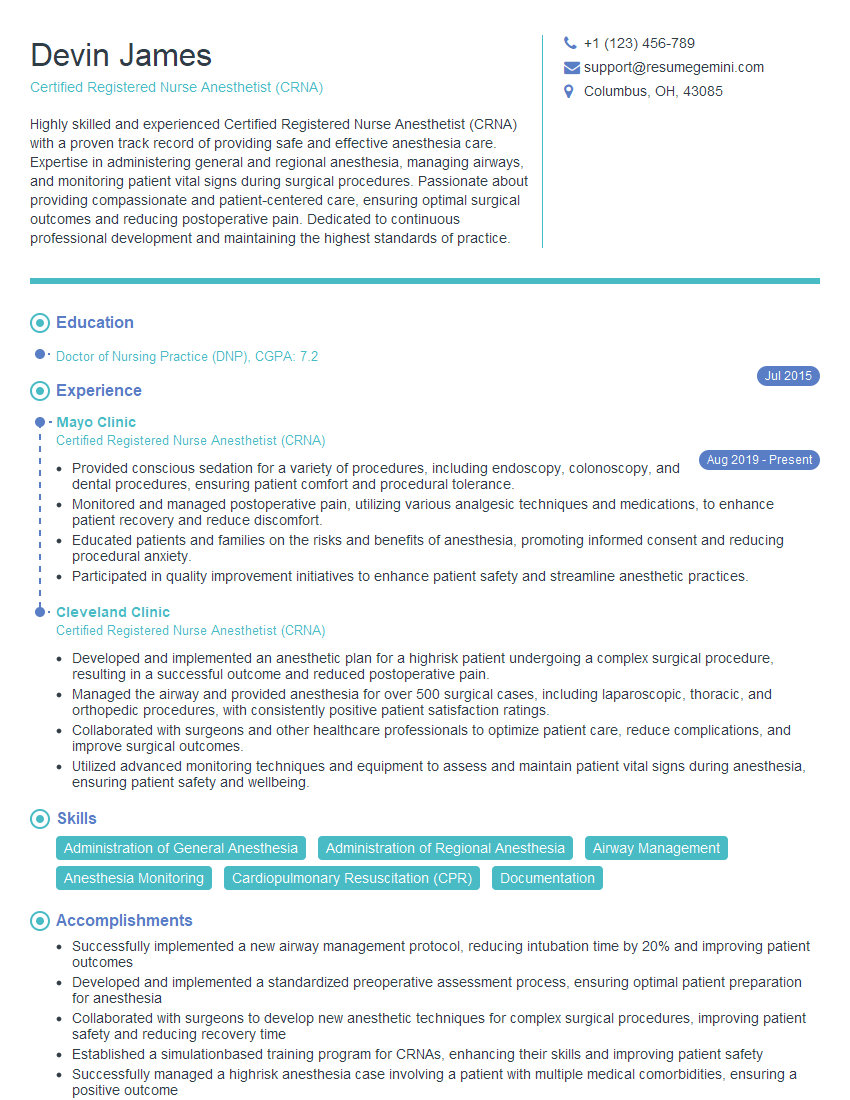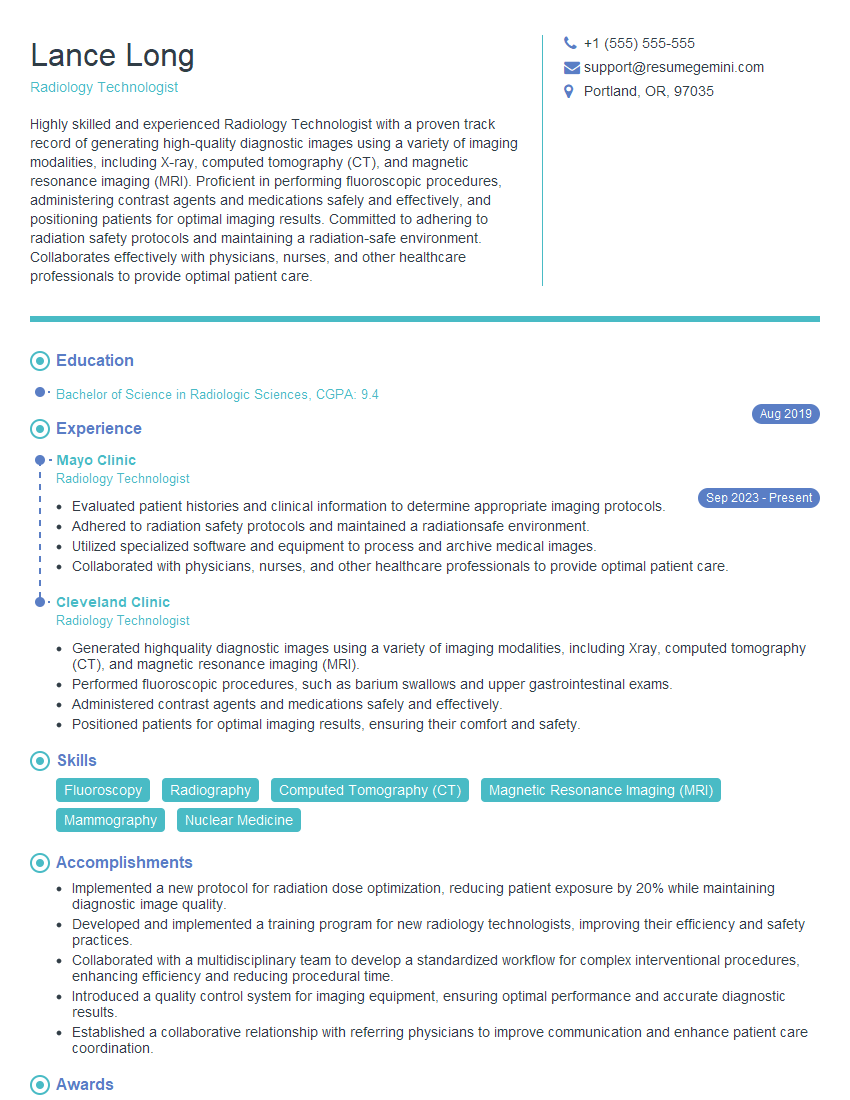Interviews are more than just a Q&A session—they’re a chance to prove your worth. This blog dives into essential Stellate Ganglion Blocks interview questions and expert tips to help you align your answers with what hiring managers are looking for. Start preparing to shine!
Questions Asked in Stellate Ganglion Blocks Interview
Q 1. Describe the anatomical location of the stellate ganglion.
The stellate ganglion, also known as the cervicothoracic ganglion, is a complex structure formed by the fusion of the inferior cervical ganglion and the first thoracic ganglion of the sympathetic trunk. It’s located in the neck, typically at the level of the C7 vertebra, anterior to the transverse process of C7, and posterior to the vertebral artery. Think of it as a crucial nerve cluster nestled deep within the neck, close to major blood vessels.
Its exact location can vary slightly between individuals, making precise localization crucial for successful stellate ganglion blocks. Understanding its relationship to surrounding anatomical structures – the longus colli muscle, the vertebral artery, and the carotid sheath – is essential for safe needle placement.
Q 2. Explain the indications for performing a stellate ganglion block.
Stellate ganglion blocks (SGBs) are employed for a range of conditions, primarily those involving sympathetic nervous system dysfunction. Key indications include:
- Complex Regional Pain Syndrome (CRPS): SGBs can provide significant pain relief in CRPS, particularly in the upper extremity.
- Post-stroke pain syndromes: Pain resulting from stroke can sometimes respond favorably to SGB.
- Raynaud’s phenomenon and other vascular disorders: By reducing sympathetic tone, SGB can improve blood flow in patients experiencing vasoconstriction.
- Headaches: Certain types of headaches, such as cluster headaches and some forms of migraine, may benefit from SGB.
- Facial pain: SGB may offer temporary relief for facial pain conditions.
It’s important to remember that SGB is often considered a therapeutic trial, and its effectiveness varies widely among patients. The decision to perform an SGB should be made on a case-by-case basis, considering patient history, symptom profile, and potential risks.
Q 3. What are the contraindications for a stellate ganglion block?
Several contraindications exist for performing a stellate ganglion block. These include:
- Active infection at the injection site: Introducing a needle into an infected area could lead to sepsis.
- Bleeding disorders: The risk of hematoma formation and bleeding is increased in patients with coagulation problems.
- Local anesthetic allergy: A history of allergy to the chosen local anesthetic is a significant contraindication.
- Patients with known cardiac pacemakers: Needle placement near the heart requires extreme caution and is generally avoided in such cases.
- Pregnancy: The potential effects of the block on fetal development are not fully understood.
A careful pre-procedure assessment is necessary to identify any potential contraindications and mitigate risks. The benefits of the procedure must be weighed against the potential risks for each patient.
Q 4. Detail the different approaches used for performing a stellate ganglion block (e.g., anterior, posterior).
Different approaches exist for performing an SGB, each with its own advantages and disadvantages. The most common include:
- Anterior approach: This approach involves inserting the needle anterior to the carotid sheath, targeting the stellate ganglion from a more superficial position. It’s often preferred due to its relative ease and reduced risk of vascular puncture, but may have a higher chance of incomplete block if not precisely placed.
- Posterior approach: In this approach, the needle is inserted posterior to the carotid sheath, targeting the stellate ganglion from a deeper position. It’s considered more technically challenging and carries a higher risk of vascular or nerve injury, but potentially provides a more complete block.
The choice of approach depends on the clinician’s expertise and the patient’s anatomy. Often a combination of anatomical landmarks and imaging guidance is employed for improved accuracy.
Q 5. What imaging modalities are commonly used during a stellate ganglion block?
Imaging guidance significantly improves the accuracy and safety of stellate ganglion blocks. The most commonly used modalities include:
- Ultrasound: Real-time visualization of anatomical structures allows for precise needle placement and reduces the risk of complications. It’s widely considered the gold standard.
- Fluoroscopy: This technique uses X-rays to visualize the needle’s trajectory and its relationship to the stellate ganglion. It provides excellent anatomical detail but involves ionizing radiation.
The choice of imaging modality often depends on local resources and the clinician’s preference. However, ultrasound is increasingly favored due to its non-invasive nature and widespread availability.
Q 6. Describe the technique for performing an ultrasound-guided stellate ganglion block.
An ultrasound-guided stellate ganglion block involves the following steps:
- Patient positioning: The patient is typically positioned supine, with the neck slightly extended.
- Ultrasound probe placement: The ultrasound probe is placed over the region of the C6-C7 vertebrae, visualizing the carotid artery, internal jugular vein, and surrounding muscles.
- Needle insertion: A small-gauge needle is advanced under real-time ultrasound guidance, aiming toward the target area (the prevertebral space). The spread of local anesthetic can be observed directly.
- Local anesthetic injection: Once the appropriate location is confirmed, a small volume of local anesthetic (e.g., 0.5-1.0 mL of bupivacaine, or other anesthetic mixture) is slowly injected. The clinician observes for spread of the anesthetic around the stellate ganglion. A small test dose is usually injected first.
- Confirmation of block: The successful placement of the needle is confirmed by observing the spread of anesthetic around the stellate ganglion under ultrasound guidance, and clinical observation of the patient’s response.
Throughout the procedure, close monitoring of the patient’s vital signs is crucial. The use of ultrasound dramatically improves accuracy and minimizes complications.
Q 7. What local anesthetics are commonly used for stellate ganglion blocks, and what are their respective advantages and disadvantages?
Several local anesthetics are commonly used for SGBs. The choice depends on factors such as duration of desired effect and patient-specific considerations. Examples include:
- Bupivacaine: Offers a longer duration of action, but may have a slower onset. It’s often preferred for procedures requiring prolonged analgesia.
- Lidocaine: Provides a rapid onset of action but a shorter duration of effect. It’s frequently used for diagnostic blocks.
- Ropivacaine: Similar to bupivacaine but potentially with a slightly lower risk of cardiotoxicity.
Advantages: Local anesthetics offer excellent pain relief while being relatively safe when administered correctly. They are usually well-tolerated, with side effects ranging from mild to infrequent serious complications, largely dependent on dose and the presence of any contraindications.
Disadvantages: Side effects can include temporary dizziness, hypotension, or, rarely, cardiac arrhythmias. Local anesthetic toxicity is a very rare but serious potential complication associated with systemic absorption. The duration of action can be a consideration, as some anesthetics may not provide sufficient relief for prolonged periods.
Q 8. How do you determine the appropriate dosage of local anesthetic for a stellate ganglion block?
Determining the appropriate dosage of local anesthetic for a stellate ganglion block is crucial for efficacy and safety. It’s not a one-size-fits-all approach; it depends on several factors including the patient’s weight, age, overall health, the specific anesthetic used (e.g., bupivacaine, ropivacaine, lidocaine), and the desired duration of the block. We typically start with a lower dose and titrate upwards as needed, always closely monitoring the patient’s response.
For example, a common starting point might be 10-15 ml of 0.5% bupivacaine with epinephrine added for vasoconstriction, which helps prolong the anesthetic effect. However, larger volumes may be needed in certain patients. The addition of a short-acting anesthetic like lidocaine can provide faster onset of action. It is absolutely vital to consider potential drug interactions and adjust dosage accordingly for patients on medications that might affect metabolism or increase bleeding risk.
It’s a process guided by experience and careful observation, always prioritizing patient safety. We carefully monitor vital signs, and if there are signs of toxicity (such as cardiovascular or central nervous system changes), we immediately stop the injection and manage the symptoms.
Q 9. What are the potential complications associated with a stellate ganglion block (e.g., Horner’s syndrome, pneumothorax)?
Stellate ganglion blocks, while generally safe, carry potential complications. Some are relatively common, while others are rare but serious. Horner’s syndrome is a relatively common complication, characterized by ptosis (drooping eyelid), miosis (constricted pupil), and anhidrosis (decreased sweating) on the same side of the face as the injection. This is typically temporary and resolves within days to weeks.
Pneumothorax, a collapsed lung, is a more serious but thankfully rare complication. It occurs when the needle inadvertently punctures the lung during the procedure. Other potential complications include bleeding at the injection site (hematoma), infection, nerve damage (rare), and accidental injection into a blood vessel (intravascular injection), which can lead to rapid absorption of the anesthetic and potential toxicity. Less common complications include esophageal perforation and phrenic nerve paralysis (affecting breathing).
Q 10. How do you manage potential complications during and after a stellate ganglion block?
Managing potential complications during and after a stellate ganglion block requires a proactive and vigilant approach. During the procedure, continuous monitoring of vital signs (heart rate, blood pressure, oxygen saturation, respiratory rate) is crucial. If a pneumothorax is suspected (e.g., sudden shortness of breath, decreased breath sounds on one side), an immediate chest X-ray is needed, and appropriate treatment, which may include chest tube insertion, will be initiated. Similarly, any signs of intravascular injection necessitate immediate management, potentially including supportive care.
Post-procedure, careful monitoring for Horner’s syndrome and other potential complications is important. If a hematoma forms, applying ice and compression may help. For infection, antibiotics are administered. Treatment for nerve damage depends on the severity and may involve pain management and physical therapy.
Q 11. Describe the post-procedure care instructions for patients who have undergone a stellate ganglion block.
Post-procedure care instructions are essential for patient safety and recovery. Patients are typically monitored for a few hours after the block, ensuring their vital signs are stable and they are comfortable before discharge. Instructions usually include:
- Avoiding strenuous activity for at least 24 hours.
- Monitoring for any unusual symptoms (e.g., increased pain, difficulty breathing, fever).
- Following prescribed pain management medication as directed.
- Reporting any complications such as significant swelling, redness, or increased pain at the injection site.
- Keeping the injection site clean and dry.
- Maintaining adequate hydration.
Specific instructions will be tailored to the patient’s individual needs and potential risks.
Q 12. What are the common side effects experienced by patients after a stellate ganglion block?
Common side effects after a stellate ganglion block are generally mild and transient. These can include Horner’s syndrome (as discussed previously), temporary neck pain or discomfort at the injection site, and a feeling of warmth or flushing in the face and neck. Some patients may experience transient hypotension (low blood pressure) or bradycardia (slow heart rate). These effects usually resolve within a few hours or days.
It’s important to differentiate between common side effects and serious complications. While the former are usually self-limiting, the latter necessitate immediate medical attention.
Q 13. How do you monitor patients for potential complications following a stellate ganglion block?
Monitoring patients for potential complications after a stellate ganglion block involves regular assessment of vital signs and careful observation for any unusual symptoms. This monitoring may include frequent checks of heart rate, blood pressure, respiratory rate, and oxygen saturation in the immediate post-procedure period. Patients are also asked about any pain, discomfort, or other symptoms they are experiencing. Further monitoring may involve regular follow-up appointments to assess the overall recovery and the efficacy of the block.
In cases of suspected complications, appropriate diagnostic tests such as chest X-rays (for pneumothorax) or blood tests may be ordered.
Q 14. What are the potential long-term effects of a stellate ganglion block?
Long-term effects of a stellate ganglion block are generally rare. In most cases, the effects are temporary and resolve within weeks. However, in rare instances, persistent Horner’s syndrome has been reported. The possibility of long-term nerve damage is also present but remains exceedingly uncommon. Thorough pre-procedure evaluation to exclude contraindications and careful execution of the procedure with appropriate monitoring significantly minimizes these risks.
It’s crucial that patients understand that the procedure is intended to provide temporary relief or diagnostic information and is not a curative measure for all conditions. The potential benefits must always be weighed against the potential risks before undertaking the procedure.
Q 15. How do you differentiate between successful and unsuccessful stellate ganglion block?
Differentiating between a successful and unsuccessful stellate ganglion block (SGB) hinges on evaluating the patient’s response to the procedure. A successful block is characterized by a constellation of symptoms, not just one isolated effect. We look for Horner’s syndrome – a triad of ipsilateral ptosis (drooping eyelid), miosis (constricted pupil), and anhidrosis (reduced sweating) – as a key indicator of successful blockade. The onset and duration of Horner’s syndrome are crucial; a rapid onset and prolonged duration suggest accurate placement. Furthermore, the patient should experience relief from their target symptoms, which might include chronic pain, complex regional pain syndrome (CRPS), or other sympathetically-mediated conditions. An unsuccessful block, conversely, exhibits little or no change in the patient’s symptoms or Horner’s syndrome. Incomplete Horner’s syndrome, or its rapid resolution, can also indicate incomplete or inaccurate block placement. It’s vital to remember that individual responses vary, and some patients may experience only partial relief even with accurate block placement. We carefully document the patient’s symptoms before, immediately after, and at follow-up appointments to objectively assess the block’s success.
Career Expert Tips:
- Ace those interviews! Prepare effectively by reviewing the Top 50 Most Common Interview Questions on ResumeGemini.
- Navigate your job search with confidence! Explore a wide range of Career Tips on ResumeGemini. Learn about common challenges and recommendations to overcome them.
- Craft the perfect resume! Master the Art of Resume Writing with ResumeGemini’s guide. Showcase your unique qualifications and achievements effectively.
- Don’t miss out on holiday savings! Build your dream resume with ResumeGemini’s ATS optimized templates.
Q 16. What are the alternative treatment options for conditions that might warrant a stellate ganglion block?
Alternative treatments for conditions treatable with SGB depend on the specific diagnosis and patient presentation. For chronic pain conditions, this might include medication management (e.g., analgesics, antidepressants, anticonvulsants), physical therapy, interventional procedures such as radiofrequency ablation or spinal cord stimulation, and psychological therapies such as cognitive behavioral therapy (CBT). In CRPS, a multi-modal approach is often necessary, potentially including medication, physical and occupational therapy, mirror therapy, and other interventional pain management techniques. For other indications of SGB, like Raynaud’s phenomenon, alternative treatments might focus on managing blood flow, such as medication to improve circulation or biofeedback. The selection of the most appropriate alternative relies on a thorough patient evaluation and a collaborative decision-making process involving the patient and the interdisciplinary team.
Q 17. Describe the role of a multidisciplinary approach in managing patients undergoing a stellate ganglion block.
A multidisciplinary approach is essential for optimal SGB management. This typically involves anesthesiologists or pain management specialists skilled in performing the block, neurologists to evaluate neurological involvement and rule out contraindications, radiologists for image guidance if needed, and physical therapists to develop a post-procedure rehabilitation plan. Additionally, psychologists or psychiatrists can provide psychological support, especially crucial in patients with chronic pain and CRPS. The patient plays a vital role in this team, contributing their history, experience, and feedback throughout the process. Regular communication and collaboration among team members ensure the patient receives comprehensive care, from pre-procedural assessment and informed consent to post-procedure monitoring and rehabilitation. For instance, in a patient with CRPS, a successful SGB might be complemented by a tailored physical therapy program and psychological support, improving the likelihood of long-term pain reduction.
Q 18. How do you assess the patient’s suitability for a stellate ganglion block before the procedure?
Assessing patient suitability for SGB requires a comprehensive evaluation. We begin with a thorough history and physical exam, focusing on the patient’s symptoms, medical history, current medications, and allergies. We assess for any contraindications such as bleeding disorders, infection at the injection site, or significant cardiovascular disease. Neurological examination is crucial to rule out any pre-existing conditions that could mimic the effects of the block or be exacerbated by it. Imaging studies, such as CT or fluoroscopy, may be used to visualize anatomical landmarks and guide needle placement, particularly in complex cases. Patients’ expectations regarding the procedure and its potential benefits and risks need to be carefully considered. A frank discussion of the procedure’s limitations, possible side effects, and alternative treatments is critical for shared decision-making. Only patients who fully understand the risks and benefits and provide informed consent should undergo the procedure.
Q 19. Explain the importance of obtaining informed consent for a stellate ganglion block.
Obtaining informed consent is paramount for ethical and legal reasons. It signifies the patient’s autonomous decision to undergo the procedure after receiving complete and understandable information about the SGB. This includes explaining the purpose of the block, the procedure’s steps and potential benefits, the associated risks (such as pneumothorax, bleeding, nerve damage, and Horner’s syndrome), and alternative treatment options. The explanation should be tailored to the patient’s level of understanding, using clear, non-technical language. Patients must be given ample opportunity to ask questions and express concerns before providing consent. The informed consent process should be meticulously documented, including the date, time, and the specific information discussed. This documentation serves as legal protection for both the patient and the healthcare provider. A poorly explained or improperly obtained consent can lead to legal complications, regardless of the procedure’s outcome.
Q 20. What are the legal and ethical considerations related to performing a stellate ganglion block?
Legal and ethical considerations governing SGB are closely intertwined with those of any interventional procedure. Strict adherence to medical standards of care, proper documentation, and obtaining informed consent are crucial for legal protection. Maintaining patient confidentiality is paramount, governed by regulations such as HIPAA (Health Insurance Portability and Accountability Act) in the US. Any complications or adverse events must be promptly reported and documented, following institutional protocols and potentially involving relevant regulatory bodies. Ethical considerations emphasize patient autonomy, beneficence (acting in the patient’s best interest), non-maleficence (avoiding harm), and justice (fair distribution of resources and care). Clinicians must continually weigh the potential benefits against the risks, and clearly communicate those risks to the patient. Furthermore, professional conduct must align with ethical guidelines established by relevant medical boards and professional organizations. This ensures the responsible and ethical practice of SGB.
Q 21. Describe your experience with different types of needles and catheters used in stellate ganglion blocks.
My experience encompasses a range of needles and catheters used in SGB. For the initial block, we commonly use 22-25 gauge needles, choosing the gauge based on patient anatomy and individual needs. These needles are typically short bevel, reducing the risk of puncturing vessels. The selection of needle type often depends on the imaging modality used (fluoroscopy vs. ultrasound). For longer-term management or continuous infusion, we utilize catheters such as 20-22 gauge flexible catheters. Material selection includes polyurethane or silicone, chosen for biocompatibility and durability. Catheter length varies based on the procedure; longer catheters are used for longer infusions and can even be tunneled if continuous administration is necessary. Our selection is always guided by safety, efficacy, and patient comfort. I’ve found that using image guidance, particularly ultrasound, greatly improves the accuracy of needle and catheter placement, minimizing the risk of complications and maximizing the chances of a successful block. The choice of needle or catheter is always part of a thorough pre-procedural planning process, considering patient-specific factors and the potential benefits and risks of each option.
Q 22. Explain your experience with managing adverse events during or after the procedure.
Managing adverse events during or after a stellate ganglion block (SGB) requires a proactive and multi-faceted approach. Potential complications, while rare, can include pneumothorax (collapsed lung), hematoma (bleeding), Horner’s syndrome (drooping eyelid, constricted pupil), and injection into a blood vessel (intravascular injection).
My approach begins with meticulous pre-procedure assessment, including thorough review of the patient’s medical history, coagulation studies, and a discussion of potential risks and benefits. During the procedure, continuous monitoring of vital signs, ECG, and oxygen saturation is crucial. I utilize real-time imaging (fluoroscopy or ultrasound) to guide needle placement and avoid complications. Should an adverse event occur, my immediate response prioritizes patient safety. For instance, a suspected pneumothorax requires immediate chest x-ray and potential chest tube insertion. Post-procedure, I closely monitor the patient for any signs of complications, providing appropriate supportive care and contacting colleagues if necessary. Documentation of all events, including any deviation from the standard protocol, is meticulous and comprehensive.
Q 23. How do you document the procedure, including complications and outcomes?
Documentation of an SGB procedure is paramount for legal, educational, and quality-improvement purposes. My documentation process follows a standardized format encompassing pre-procedure assessments (patient history, physical examination, informed consent), procedural details (type of block, needle approach, imaging modality used, volume and type of anesthetic solution, location of needle tip verified by imaging), intra-procedural events (any complications encountered, management strategies, and response to treatment), post-procedure findings (vital signs, any adverse events experienced by the patient), patient education, and instructions provided. I meticulously document any complications, including the type, severity, treatment administered, and patient response. Outcome measures, such as pain relief, duration of effect, and any lingering side effects, are also meticulously recorded. This detailed documentation process facilitates accurate tracking of patient outcomes and helps identify potential areas for improvement in technique and patient management.
Q 24. Describe your experience working with different imaging modalities (fluoroscopy, ultrasound).
My experience encompasses both fluoroscopy and ultrasound-guided SGBs. Fluoroscopy provides excellent visualization of bony landmarks and needle position, ensuring accurate needle placement in the vicinity of the stellate ganglion. However, it involves ionizing radiation, which necessitates minimizing exposure time. Ultrasound, conversely, provides real-time imaging without ionizing radiation and allows for excellent visualization of soft tissues and anatomical structures, aiding in accurate needle placement and avoiding unintended vascular punctures. The choice between the two modalities depends on the patient’s clinical status, specific anatomical considerations, and availability of equipment. In many instances, I prefer ultrasound-guided techniques for their safety profile and real-time feedback. I am proficient in both techniques and can adapt my approach based on the individual patient needs and procedural context. I see a growing trend towards utilizing ultrasound, reflecting its safety and effectiveness.
Q 25. How do you stay updated on the latest advancements in stellate ganglion block techniques and safety protocols?
Staying current with advancements in SGB techniques and safety protocols is a continuous process. I actively participate in professional organizations like the American Society of Regional Anesthesia and Pain Medicine (ASRA), attending national and international conferences to learn about the latest research and clinical practices. I regularly review peer-reviewed medical literature, including journals such as Anesthesiology, Pain Medicine, and Regional Anesthesia and Pain Medicine. Additionally, I actively participate in continuing medical education (CME) courses focused on interventional pain management and ultrasound-guided procedures. This multi-pronged approach ensures that I maintain the highest standards of care while utilizing the most up-to-date, evidence-based practices. Staying connected with colleagues through professional networks also provides invaluable opportunities for knowledge exchange and sharing experiences.
Q 26. What is your understanding of the evidence-based practice related to stellate ganglion blocks?
Evidence-based practice is central to my approach to SGBs. The existing literature supports the efficacy of SGB in various conditions, such as complex regional pain syndrome (CRPS), post-herpetic neuralgia, and certain types of headaches. However, the evidence base varies across different indications and remains a subject of ongoing research. For example, while some studies show promising results for SGB in CRPS, the long-term efficacy and optimal treatment protocols are still debated. My practice relies on critically appraising the existing research, considering the specific patient’s clinical presentation, and tailoring the intervention accordingly. I strive to balance the potential benefits of the procedure with the potential risks, making individualized decisions based on the best available scientific evidence and considering patient preferences.
Q 27. How do you handle patient anxiety and pain management before and after the procedure?
Addressing patient anxiety and managing pain before and after an SGB is crucial for a positive patient experience and optimal procedural outcomes. Pre-procedure, I thoroughly explain the procedure, addressing the patient’s concerns and questions. I utilize a combination of pharmacological and non-pharmacological approaches to manage anxiety. This can include pre-procedure anxiolytics or mild sedation, along with relaxation techniques such as deep breathing exercises or guided imagery. Post-procedure, pain management strategies might include local anesthetic infiltration at the injection site, oral analgesics, or nerve blocks as needed. Open communication with the patient regarding expected sensations, potential side effects, and pain management strategies is critical for minimizing anxiety and ensuring a comfortable recovery. I make sure patients have a clear understanding of the post-procedural care instructions and are comfortable contacting me if any concerns arise.
Q 28. Describe a challenging case involving a stellate ganglion block and how you resolved it.
One challenging case involved a patient with severe CRPS in their arm, refractory to previous treatments. Initial attempts at ultrasound-guided SGB were unsuccessful due to significant anatomical distortion and scar tissue from previous surgeries. The patient was experiencing intense pain and anxiety. After careful review of the patient’s imaging and history, I opted for a combined approach using both ultrasound and fluoroscopy to gain a clearer understanding of the anatomical landmarks. This allowed me to carefully navigate around the scar tissue and accurately place the needle. I also implemented a multimodal pain management strategy incorporating a local anesthetic cocktail tailored to the patient’s needs, along with physical therapy and psychological support. This combined strategy proved successful; the patient experienced significant pain reduction, allowing them to begin physical therapy and improve their overall functional status. This experience reinforced the importance of adapting techniques, utilizing available imaging modalities judiciously, and employing a holistic approach to pain management.
Key Topics to Learn for Stellate Ganglion Blocks Interview
- Anatomy and Physiology: Thorough understanding of the stellate ganglion’s location, anatomical relationships, and its role in the sympathetic nervous system.
- Indications and Contraindications: Mastering the criteria for selecting appropriate patients and identifying situations where the procedure is unsuitable.
- Procedure Technique: Detailed knowledge of different approaches (anterior, posterior, ultrasound-guided), needle placement, and injection techniques.
- Anesthetic Considerations: Understanding the choice of local anesthetic agents, volumes, and potential complications related to anesthetic administration.
- Complications and Management: Proficiency in recognizing and managing potential complications, such as pneumothorax, Horner’s syndrome, and bleeding.
- Post-Procedure Care: Knowledge of patient monitoring, potential side effects, and instructions for post-procedure recovery.
- Imaging and Interpretation: Ability to interpret fluoroscopic or ultrasound images to confirm needle placement and assess potential complications.
- Evidence-Based Practice: Familiarity with current research and clinical guidelines related to Stellate Ganglion Blocks and their effectiveness.
- Patient Communication and Consent: Understanding the importance of clear communication with patients, obtaining informed consent, and managing patient expectations.
- Troubleshooting and Problem-Solving: Ability to analyze and address technical challenges encountered during the procedure, such as failed needle placement or unexpected complications.
Next Steps
Mastering Stellate Ganglion Blocks demonstrates advanced procedural skills and a deep understanding of regional anesthesia, significantly enhancing your marketability in the competitive field of interventional pain management or anesthesiology. To maximize your job prospects, a well-crafted, ATS-friendly resume is crucial. We strongly encourage you to use ResumeGemini, a trusted resource, to build a professional resume that highlights your expertise. ResumeGemini provides examples of resumes tailored specifically to Stellate Ganglion Blocks expertise, giving you a head start in creating a compelling application.
Explore more articles
Users Rating of Our Blogs
Share Your Experience
We value your feedback! Please rate our content and share your thoughts (optional).
What Readers Say About Our Blog
This was kind of a unique content I found around the specialized skills. Very helpful questions and good detailed answers.
Very Helpful blog, thank you Interviewgemini team.
